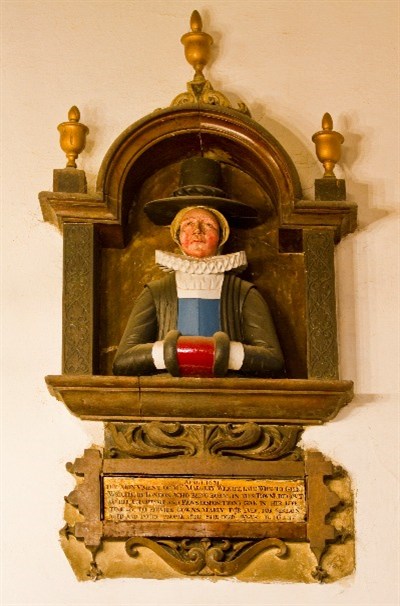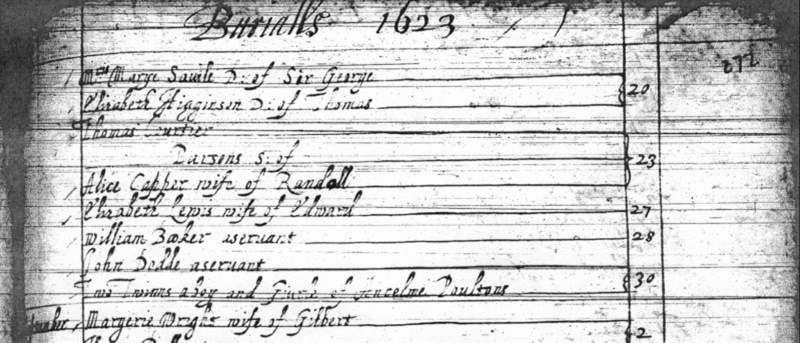Margery Wright

A wooden effigy of a woman hangs above the south door of St Helen’s Church. The plaque beneath it reads:
“April 1 1631. The monument of Mrs Margery Wright, late wife to Gilb.Wright of London,who being borne in this towne did (out of her charitable and pious disposition) give in her life time £46 to provide gowns yearly for ever, for certain aged and poor people. Here she died August 11 1623.”
A Woman
The earliest information we have about Margery Wright is from the registers of the church of St Clement Dane in London, in 1603.

Marriage register: record of Margery’s marriage to Gilbert, St Clement Danes. 1603/4
When Margery married Gilbert, her surname was recorded as 'Gogyn.' Further examination of the records of St Clement Danes has brought up a record of Gilbert and Margery's marriage licence, transcribed into a book. The record reads:
Wright, Gilbert of Christchurch, London, salter, and Margery Goodgin, of St Clement Danes, widow of Robert Goodgin, late of same, cook-at St Clement Danes aforesaid. 23 Dec 1603. B.
This tells us that Margery was a widow. Her previous husband had been buried at St Clement Danes on 23rd October 1603. She married Gilbert Wright just 2 months later.

Burial register: record of Robart Goodgyn’s death. St Clement Danes, 1603.
As an aside, it's interesting to note the fluidity of spelling in these documents. In the marriage register, Margery's surname is "Gogyn," in the marriage licence it's "Goodgin" and in Robart's burial record it's "Goodgyn." Margery's first name is written "Margerie" in her burial record. Discrepancies like this make the historical researcher's job slightly more challenging!
We know nothing more about the life of Gilbert & Margery Wright until 1620, when William Lilly of Diseworth moved into the Wright household to work for Gilbert. It’s from Lilly’s book that we learn that Gilbert “was born at Market Bosworth … my mistress (Margery) was born at Ashby de la Zouch.” Lilly also records that Gilbert married Margery for her money, “she was competently rich” and that at the time Lilly arrived in London Margery was “about seventy years of age, he (Gilbert) sixty-six or more.” Lilly also writes in moving terms about Margery’s final illness and her death and burial.

Burial register: record of Margery Wright’s burial, St Clement Danes. 1623.
Extrapolating from what William Lilly writes in his book, if Margery was around 70 years old in 1620, she must have been born around 1550. Parish registers were formally introduced in England and Wales in 1538 when Thomas Cromwell, chief minister to Henry VIII, issued an injunction requiring that in each parish of the Church of England registers of all baptisms, marriages, and burials be kept. However, St Helen’s’ registers date back to 1561, some ten years after the likely birth date of Margery Wright. We also still don’t know her surname at birth and we don’t know whether she was born into a well-to-do Ashby family or gained her wealth in later life from marrying well.
A Monument
We do not know who commissioned Margery Wright’s monument in St Helen’s. It may have been her husband or a relative or perhaps she commissioned it herself.
The monument is of wood and we believe it was made by Hugh Hall, who was active in Ashby between around 1611 and the late 1630s. We see Margery in a white ruff and blue bodice, though the present decoration of the monument is by no means original. It has been cleaned and repainted regularly, most recently in the 1970s, when it was repainted after the whole church was steam cleaned!
A Ledger
A ledger, started in 1657, and now in the care of the Leicestershire Records Office, gives details of lands purchased by the trustees of Margery Wright’s Charity. The charity owned land at ‘Linford Hall’ and at ‘Newtowne’ and Blackfordby, which was let to local farmers. Trustees collected rents from tenants at half yearly intervals. The money was used variously to secure apprenticeships for poor boys with local tradesmen and to buy cloth to make gowns for the poor.
For example, in 1658, the total collected for half a year’s rent was £7 7 shillings.
From that, the trustees “hath layd it out forthwith … for Beautifying Mrs Wright’s monument 10/-“
Other income was used:
-
” to make gowns for three poor people and a yard of cloth given to Matthew Hood’s child” £2, 4shillings and 8d
-
“for binding Robert Ridgway to Robert Tindall as an apprentice to learn the traid … £5 12 shillings.”
This pattern continued to be followed for many years. Rents were collected by two appointed trustees and monies were paid out to buy cloth and make gowns & coats and to secure apprenticeships for the sons of poor people.
Any monies left over were put back into the charity ‘pot’ towards the next series of gifts.
The ledger ceased to be used in 1754 but we know that the charity was still active in 1881. Books of printed invitations still exist, both in the Church archive and in the care of Ashby Museum. One such invited Martha Wootton of Boundary ‘
to wait on Mr Emery, Draper, Ashby de la Zouch, at once and be measured for a gown and to attend at the Parish Church on Wednesday 7th December 1881 at two o’clock in the afternoon to receive the same from the Trustees of the Charity’. There are similar records from 1884, when recipients were invited to attend at the church ‘to receive Gift from the Trustees’.
Several charities had been merged by 1884, when all of the charities’ endowments were administered and managed by the bodies of Trustees under the title ‘The United Charities’, which became the ‘Ashby Educational Foundation’ in 1912 and exists to this day to promote the education (including the social and physical training) of people under 25 living in the Ashby area who have attended a school in the area.
There are many things we still don’t know about this woman, who died more than 400 years ago. One thing is certain, however. Her generosity and forethought has helped many people in the four centuries since her death.
Sources:
Information from Marriage & Burial Registers of St Clement Dane & from Gould Genealogy - Find My Past
William Lilly's History of his Life & Times from the year 1602 to 1681. Published London 1715. Google Books
Margery Wright's Charity Ledger - St Helen's Parish Records, Leicestershire Records Office.
Ashby Educational Foundation - Ashby School website.
Julie Starkey, 19/08/2020